Notes: When, Where & How | Social Studies & Pedagogy Paper 2 for CTET & TET Exams - CTET & State TET PDF Download
| Table of contents |

|
| Introduction |

|
| Types of Sources |

|
| Inscriptions |

|
| Numismatic |

|
| Literary Sources |

|
History which means knowledge acquired by investigation, is the study of the past as it described in written documents. It is an umbrella term that related to the events. The culture and civilisation, which were prevalent in the past and documented are studied in the book of history. It gives us the accounts of the rulers, traders, peasants, craftmen, artists, musicians or scientists etc of the past time and also about their behaviour and how they used to live their day-to-day life. It can be said that history presents the evidence from the past to the present and future.
Introduction
- Social science has a specific nature, which is based on the principle of understanding of society.
- As a subject, Social science is a group of various disciplines such as Political Science, Geography, Economics, and History.
- Most of the disciplines of Social science deal with the present scenario of society, but history is the only discipline that not only deals with present but also deals about our past.
- History is a subject that gives us insight to understand our past through a journey with time and space. However, another pertinent question is how do you come to know about our past? What are the ways that help us to know our past? Are these ways authentic and qualitative? Some other kinds of questions are: why do we introduce history at school level? What is to be taught in history at various levels? Why do we teach what we teach?
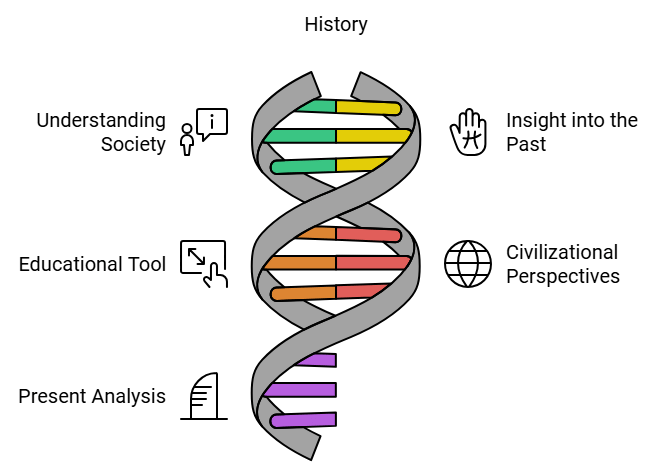
- History is not merely a subject; rather, it is a powerful tool that facilitates interaction between the present and the past. It is important to understand that there are various ideas about various civilisa- tions across the world, and Indian civilisation is considered as one the oldest civilisation. However, along with this, we should also understand that the qualities and characteristics prevailed to define a state is different from the present. In addition, when we try to see history only from the present point of view or to legitimate present situation and scenario, it takes us to a different kind of problem.
- History is one subject that not only develops our understanding about our society in the past but also develops the ability to become familiar about the present form of society that emerged after a long journey of freedom struggle. Therefore, introducing history as a subject in school education facilitates the learners the conceptualisation of their own past, which will help them to analyse their present.
How to Know Our Past
There are several ways to know about our past such as through monuments, reading books and the available written materials that introduce us to the past, listening to folk songs, and so on. However, the fundamental question is: what is the source? It is needless to say that the source is most important to know about the past especially if you want to know the history of any particular time and space. Another question which rises here is that what is a historical source? A material that has some important and useful and reliable information of history about a particular time is called a source in history such as books, monuments, folk songs, stories, and so on. In history, sources are most important because they are the base of understanding about the past. These sources give us an insight to understand the contemporary situation of any particular time period. There are many types of sources, but for convenience, all these sources are divided into two broad categories, namely primary sources and secondary sources. Apart from these two sources, historians also use two more categories, namely archaeological sources and literary sources.
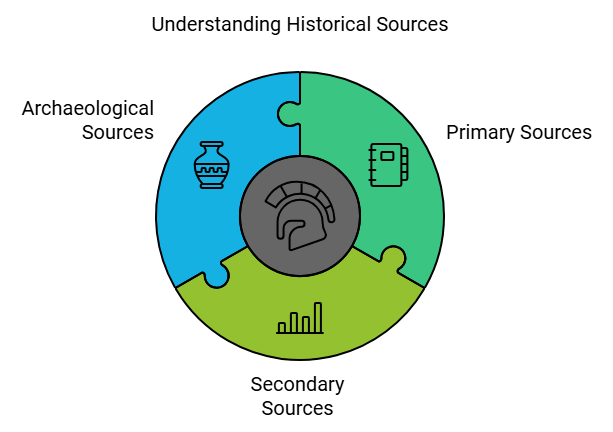
Types of Sources
Primary Source of History
- The primary sources are sources that are not manipulated by anyone. These are more reliable and authentic sources. Primary sources are like chronicles, travellers accounts, coins, monuments, palaces, forts, royal farmans, official orders, court bulletins, historical letters, religious literature, inscriptions, and so on.
Secondary Sources of History
- The secondary sources of History are based on primary sources. These types of sources are basi- cally interpretations of primary sources. These sources are also important because they present different types of aspects and interpretations of the same source.
Archaeological Sources
- Archaeological sources are those ancient ruins, remains, and monuments that are recovered as a result of excavation and exploration of various sites. As in Madhya Pradesh, excavation and explo- ration near the river Narmada helped us to know how people survived during this period which is known as a period of hunting and gathering. Another such example is Bhimbetka caves where wall paintings depict the contemporary lifestyle of ancient people. We can also assume about their hunting and other such activities. Figures 1.1 and 1.2 present the life of ancient people.
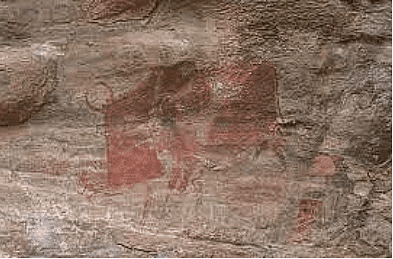 Figure 1.1 A mythical animal and humans, Bhimbetka
Figure 1.1 A mythical animal and humans, Bhimbetka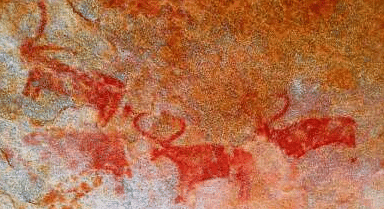 Figure 1.2 Prehistoric rock paintings, Bhimbetka
Figure 1.2 Prehistoric rock paintings, Bhimbetka
Another pertinent question is how we can authenticate the originality of archaeological sources with reference to their time period. The archaeologists have some processes through which the chronology of any source can be identified. This process is known as radiocarbon dating, which is based on scientific inquiry. We are aware of the fact that throughout a period, many monuments had got buried due to various reasons. To know and reveal about these time periods, we have to excavate these buried areas. This is a work of professional excellence and skill, where everything is procured carefully. The process of excavation helped us to known about Mohenjo-Daro (see Figure 1.3) and Dholavira (see Figure 1.4). Many other such facts of history have been and can be unrevealed with the help of archaeology.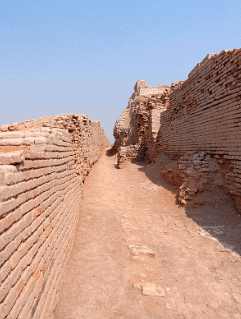 Figure 1.3 A street of Mohenjo-Daro
Figure 1.3 A street of Mohenjo-Daro Figure 1.4 Reservoir at Dholavira
Figure 1.4 Reservoir at Dholavira
Inscriptions
Inscriptions are a kind of archaeological source. These inscriptions are considered as the most valuable historical sources, because inscription gives us written information about a time period. These inscriptions are old and their language is not known to the people in present time. If the languages of these inscriptions are unknown, then how one can read and make sense of these inscriptions is an important question. With the help of epigraphy, these inscriptions can be read and analysed. We should also know that the writing on inscription is known as palaeography. The inscriptions are usually available on rocks, pillars, stones, slabs, walls of buildings, different kinds of seals, and copper plates. Mostly these inscriptions are related to royal proclamations and commandments. Figure 1.5 A Ashoka’s inscription
Figure 1.5 A Ashoka’s inscription
 Figure 1.6 Ashokan inscription, Kandahar, Afghanistan
Figure 1.6 Ashokan inscription, Kandahar, Afghanistan
Other inscriptions are related to religious activities such as the ones found in temple walls, pillars, stupas, and monasteries. These inscriptions and their location not only provide valuable information but also help us to understand the sociocultural, religious, and political aspects of contemporary life, such as King Ashoka’s inscriptions (see Figures 1.5 and 1.6) help historians to understand the outer boundaries of Ashokan empires.
Numismatic
Coins are a part of our daily life but have you ever thought about the study of coins? This study is known as numismatics. Coins are another source of historical information. There were different types of coins in different eras such as the coins of 500 BC are known as punch-marked coins. There was no fixed shape on the punch-marked coins; these are pieces of metal that are punched by sign or symbol, and that is why these coins are called punch-marked coins. In the era of Kushans, gold coins were introduced first time in India. Gupta period is known for their silver coins. Now you can see that various kinds of metals are used to make coins in different areas. Is there any difference in using different types of metals to make coins? Metals used in the coins actually represent the economy of the time or kingdom, for example, when gold was sued for coin making, it shows that the economy was in better conditions, and if silver was used, the economy is less prosperous in comparison to the gold economy. Coin shapes also help to understand the metal melting technol- ogy of a particular time period. Coin inscriptions are also important because they help us to know about the ruling person of that era. Some examples of coins are shown in Figures 1.8–1.10.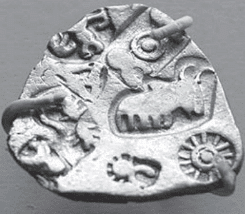 Figure 1.8 Punch-marked coins
Figure 1.8 Punch-marked coins Figure 1.9 Gold coins of Kushans
Figure 1.9 Gold coins of Kushans
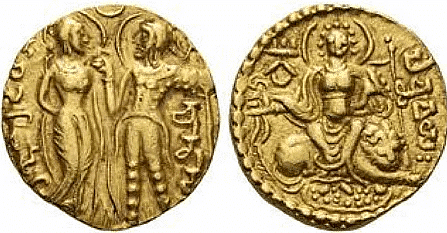 Figure 1.10 Gupta’s coins
Figure 1.10 Gupta’s coins
Literary Sources
Literature is important because it is the mirror of a society. Literature gives insight to understand about society, political structure, economy, and their religious rituals of a particular time. There are different types of literature available like religious literature, secular literature, accounts of for- eigners, state chronicles, and so on. The religious accounts are available in a large range and are commonly divided into two main categories: Brahmanical and Non-Brahmanical literary sources. Brahmanical literature includes Vedas, Puranas, Upanishads, and the great epics (Ramayana and Mahabharata). The religious literature of Jains and Buddhist are known as Non-Brahmanical liter- ary sources of history.There are some literatures that are not related to any particular ideology. These sources are called secular literatures such as Kautilya’s Arthashastra, Patanjali and Panini writings, dramas of Kalidas, and Kalhana’s Rajatarangini. All these historical texts have great value.
Time to time foreigners visited India. Some of them wrote some valuable accounts of their travels like Megasthenes’ Indica, Ptolemy’s Geography, and Al-Beruni’s Kitab Al-Hind. These are some of the well-known accounts written by foreigners. Accounts of foreigners are important because they provide information related to contemporary time and also validate the other contemporary texts.
There are other types of literature sources such as state chronicles. State chronicles are impor- tant because they provide systematic and authentic information about state affairs, such as revenue records. They also represent the state’s perspective about certain issues. Especially in medieval era, state-sponsored chronicles were prepared at large scale. The British also prepared such chronicles which are known as gazette. There are some examples of state-sponsored chroni- cles such as Ain-i-Akbari, Revenue Records, and Bengal Gazette (see Figures 1.11 and 1.12).
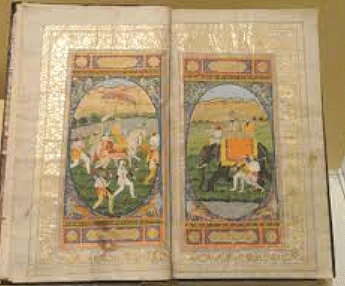 Figure 1.11 Ain-i-Akbari
Figure 1.11 Ain-i-Akbari
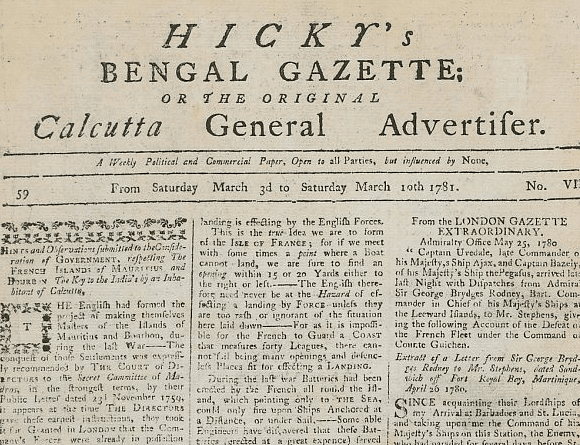 Figure 1.12 Bengal Gazette
Figure 1.12 Bengal Gazette
|
75 videos|322 docs|78 tests
|
FAQs on Notes: When, Where & How - Social Studies & Pedagogy Paper 2 for CTET & TET Exams - CTET & State TET
| 1. What are inscriptions and how do they help us understand our past? |  |
| 2. What types of literary sources can be used to learn about history? |  |
| 3. How can we verify the authenticity of inscriptions and literary sources? |  |
| 4. Why are inscriptions considered more reliable than some literary sources? |  |
| 5. How do CTET and State TET incorporate the study of history through inscriptions and literary sources? |  |
















